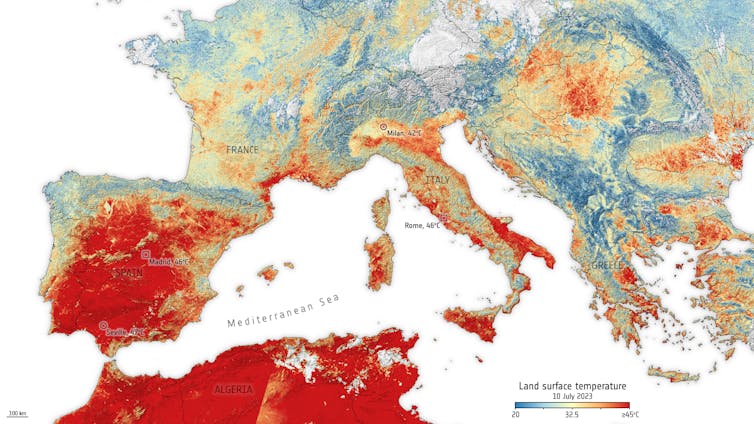
Europe is currently in the midst of a heatwave. Italy, in particular, is expected to face blistering heat, with temperatures projected to reach 40℃ to 45℃. There’s even a chance that the current European temperature record of 48.8℃, set in Sicily in 2021, could be surpassed.
Searing temperatures have spread to other countries in southern and eastern Europe, including France, Spain, Poland and Greece. The heat will complicate the travel plans of those heading to popular holiday destinations across the region.
Heatwaves, which are defined as prolonged periods of exceptionally hot weather in a specific location, can be extremely dangerous. Europe has experienced its fair share of devastating heatwaves in the past.
In 2003, a heatwave swept across Europe, claiming the lives of over 70,000 people. Then, in 2022, another heatwave hit Europe, resulting in the deaths of almost 62,000 people.
The current heatwave is being caused by an anticyclone named Cerberus after the three-headed monster-dog that guards the gates of the underworld in Greek mythology. An anticyclone – or high-pressure system – is a normal meteorological phenomenon in which sinking air from the upper atmosphere brings about a period of dry and settled weather with limited cloud formation and little wind.
High-pressure systems tend to be slow moving, which is why they persist for days, or even weeks at a time. They often become semi-permanent features over large areas of land. When high pressure systems form over hot land, in regions like the Sahara, the stability of the system generates even hotter temperatures because the already warm air is heated even more.
Eventually, the anticyclone will weaken or break down and the heatwave will come to an end. According to the Italian Meteorological Society, the Cerberus heatwave is expected to persist for around two weeks.

What role does climate change play?
High pressure systems, like the one currently affecting Europe, have been expanding northwards in recent years. It’s difficult to ascribe a single event, such as a heatwave, directly to climate change. But as temperatures continue to warm, we are seeing changes in atmospheric circulation patterns that can lead to increased occurrences of extreme temperatures and drought in Europe.
Research by the Intergovernmental Panel on Climate Change confirms this trend. Its data shows an increase in the frequency and magnitude of extreme weather events since the 1950s. A separate analysis of European heatwaves revealed an increasing severity of such events over the past two decades.
In the summer of 2022, southern Europe experienced higher temperatures than usual for that time of the year. Spain, France and Italy saw daily maximum temperatures exceed 40°C. The EU’s Copernicus Climate Change Service attributed these unusually hot conditions to climate change and suggested that such events are likely to become more frequent, intense and last longer in the future – indicating a concerning trend that may continue this year.

The dangers of extreme heat
Heatwaves and extreme temperatures impact human health in a number of ways. These conditions can cause heatstroke, leading to symptoms like headaches and dizziness. Dehydration resulting from the heat can also affect respiratory and cardiovascular performance.
There have already been reports of heat-related health incidents in Europe during the ongoing heatwave. An Italian road worker died, and there have been numerous cases of heatstroke reported across Spain and Italy.
The Italian Ministry of Health has advised residents and visitors in affected areas to take precautions like staying out of the sun during the hottest part of the day, remaining hydrated and to avoid alcohol consumption.
But the effects of heatwaves go beyond individual health. They have broader social and economic consequences too. Extreme heat can damage road surfaces and even cause railway tracks to buckle.
Heatwaves can also lead to reduced water availability, affecting electricity production, crop irrigation and drinking water supply. In 2022, scorching heat meant French nuclear plants were unable to run at full capacity as higher river temperatures and low water levels affected their cooling ability. Research indicates that extreme heat has already had a negative impact on economic growth in Europe, lowering it by up to 0.5% over the past decade.

As temperatures continue to rise, heatwaves will become more severe. It’s crucial that governments worldwide take swift and decisive action to reduce greenhouse gas emissions immediately.
However, it’s important to note that even if we were to completely halt global greenhouse gas emissions today, the climate would still continue to warm. This is due to the heat that is already absorbed and retained by the oceans. While we can slow down the rate of global warming, the effects of climate change will continue to be experienced in the future.
![]()
The authors do not work for, consult, own shares in or receive funding from any company or organisation that would benefit from this article, and have disclosed no relevant affiliations beyond their academic appointment.



